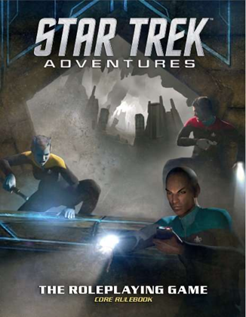 I recently played the first of the Star Trek Adventures organised play adventures, Decision Point. It was my first experience with the system, which meant we ignored a lot of the mechanics and concentrated on the story.
I recently played the first of the Star Trek Adventures organised play adventures, Decision Point. It was my first experience with the system, which meant we ignored a lot of the mechanics and concentrated on the story.
The story revolved around an ethical dilemma: Do we break the Prime Directive of Starfleet (non-interference) and save some of the population of a doomed planet? Or do we observe the Prime Directive and let everyone die?
This could be a fantastic tale. It didn’t work so well for us.
We ran into a basic problem: None of the players was on the opposite side of the debate! We all agreed not to break the Prime Directive, and the largest source of tension was gone. Oops! In such a situation you would like players on either side of the issue or undecided in the middle and available to be swayed by argument.
I think one of the problems with the situation was this: We weren’t given a reason to care. There were no alien NPCs that were sympathetic. We weren’t given a glimpse of the alien characters’ lives, and we had no reasons to empathize with them.
This sort of stuff can be difficult to pull off in an RPG, especially in an episodic game where the entire scenario plays out in one session. In a multi-session game, you have more time to build up the characters’ relationships with the NPCs. It gets easier. In a single session? You must hit it early and do it well. Can it be done? The Inner Light is a 42-minute TV episode of Star Trek: The Next Generation that makes you care very much about the (doomed) characters. It should be very achievable in a 4-hour RPG session.
It helps when the dilemma is well-defined and isn’t overcomplicated. I felt this situation had problems. The two choices were:
- Break the Prime Directive, save a small portion of the planet’s population, but endanger another race
- Keep the Prime Directive, not save the planet’s population, but save the other race
The involvement of the other race made the decision significantly easier for each of us. As we didn’t care for any members of the doomed race, why should we endanger another one?
It’s easy to see what I’d prefer. You’ve got to care about the decision and the people in it.
There are times when the situation is sufficient to give the conflict. There are a few elements that instantly engage people, such as endangering children. The trouble is those elements can also be triggers for some players. However, the entire business of using an ethical dilemma gets you into those areas. They’re meant to be serious; they’re meant to challenge people. If a player finds one too challenging, that’s the time to be sensitive and adapt and adjust.
Cutting down the design to avoid triggers? If you’ve got a game which should be about these tough decisions – as I believe Star Trek Adventures should be – then you run the risk of neutering it. Do we remove challenging material just because a few people won’t be able to handle it? I’d prefer not. A lot comes down to how the GM handles it.
Getting the players to care about the situation is a real challenge of design. Use NPCs, use the situation, use whatever tools you can to engage the players. Don’t assume the players will automatically follow along. There are times everything fails, but at least be aware of the possibilities. If you can get the characters to befriend an NPC; you’ve accomplished something that helps a lot when that NPC will be affected by the choices of the players.
If the decision is hard and has consequences? That’s what you want!
